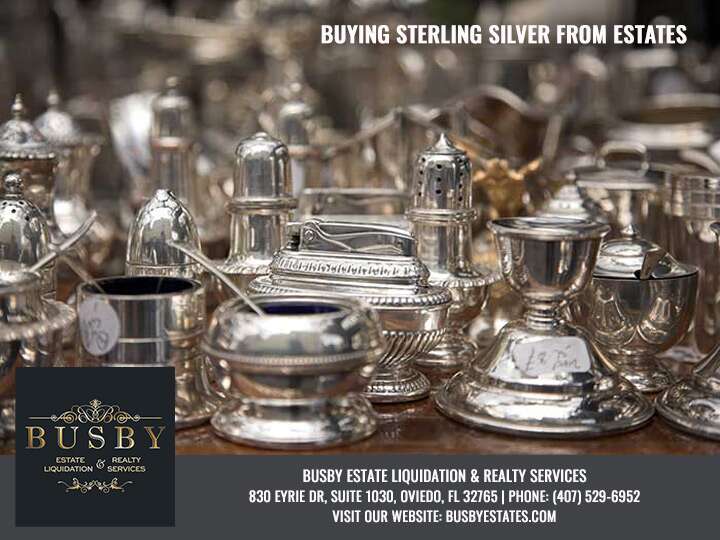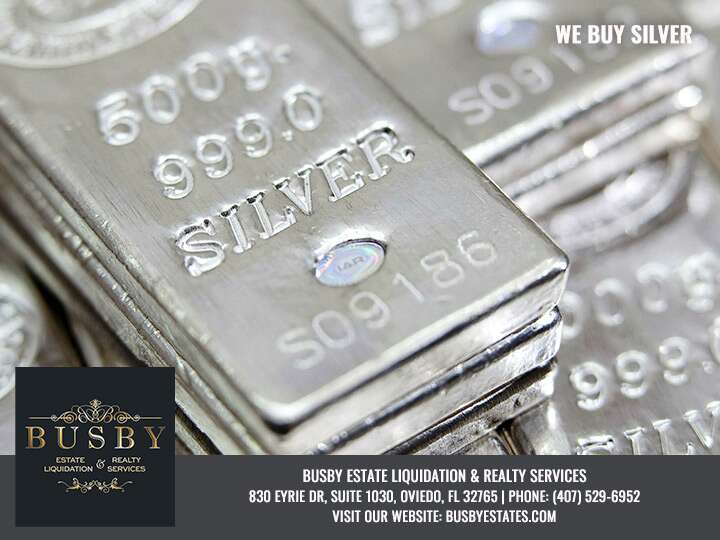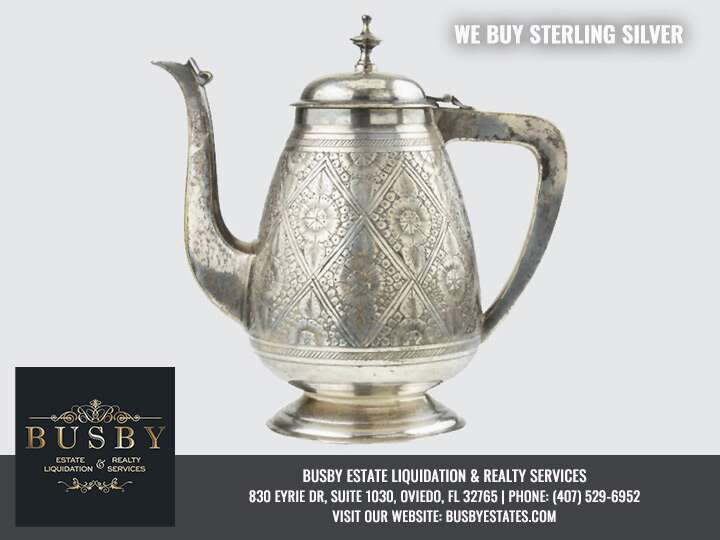Buying Sterling Silver from Estates
We Buy Sterling, Continental, Coin, and Asian Silver
Identification of sterling or silver flatware and holloware takes years of experience and education. Fortunately, we have over 30 years of experience in this field! Before we dig deeper, let’s define exactly what we are talking about
Types of Silver
- Sterling Silver — refers to the “sterling” standard of 92.5% purity. This standard originated in England and was actively in use as early as the 12th century. It is currently that standard for all of the UK, the US, and many other countries in the 6 continents that produce silver.
- Continental Silver – a catch-all name for all other European silver of various purities, generally ranging from 80% to 90% purity.
- Coin Silver — US silver was made from 90% silver us coins, before the US informally adopted the Sterling standard in approximately 1860.

As a general rule, most modern silver will be marked with the word “Sterling” or a decimal number indicating the fineness of the silver, such as .800, .830, .835, .900, .950, 84, 916, and a few other less common variants. What makes silver a tricky field is that nearly all antique silver will be marked only with Hallmarks (impressed marks that denote the fineness of silver, country, and date of origin, assay office, or city, amongst other things).
We’ve been dealing in silver long enough to be able to immediately identify the country of origin of about 95% of all antique silver we see, and can quickly use our reference library to identify the remaining 4.95% (there are always a few rare mysteries marks out there that require in-depth research). As a general rule, pieces that pre-date large-scale political upheavals are typically rarer and have a higher value (think Russian and French Silver pre-revolutions, US Southern Silver Pre-Civil war, etc), whereas silver from countries with very stable governments tends to be less valuable due to higher supply.

Here are some of the more notable areas of collecting from various countries:
- US COIN SILVER — US Coin silver is typically marked with a rectangular punch mark with one or two names (typically the last name or name of the makers) or sometimes only with initials. The best US coin silver is typically Southern Coin Silver. Pre-Civil War, the South was generally less industrialized than the North, and prolific silversmiths were somewhat rare. Silver makers from the Carolinas, Georgia, Louisiana, and other Southern states will generally be worth considerably more than their Massachusetts or New York comparable items.
- US STERLING SILVER – Better-known makers are Gorham, Tiffany & Co, Reed & Barton, and too many others to name. Some of the better forms are the Aesthetic period (especially mixed metal pieces with copper and brass bugs and butterflies), pieces with enamel decorations, Art Nouveau and figural motifs, and hand-raised or handmade pieces (Gorham’s Martele line, for example).
- ENGLISH, SCOTTISH AND IRISH SILVER — Typically not marked with the word “Sterling, but rather with a set of specific hallmarks that allow you to determine the piece’s City and Year of origin, and the specific maker. Will also sometimes include a duty mark that has a profile of the reigning monarch at the time of manufacture.
- FRENCH AND JAPANESE SILVER — I only group these together because they both use a .950 purity standard. Most Japanese pieces will be marked “.950” and possibly with the word “silver”. Most French silver will use a hallmarking system similar (but much less specific) to the English system. Some of the better-known French luxury silver makers are Christofle, Puiforcat, and Cartier.
- MEXICAN STERLING AND SILVER – Standards of .925, and .950 are common in Mexican silver, with .980 also being used for a brief period. There are many fantastic makers of Mexican silver, and many very influential jewelry makers from the city of Taxco, like William Spratling (an American designer who set up shop in Taxco), Margo De Taxco, and Los Castillo, and many others. Also, there are many Mid-Century Modern pieces made in Mexico that emulate their Scandinavian counterparts.
- EUROPEAN CONTINENTAL SILVER – European countries use a wide variety of purities and marking systems for their silver. While many now use the Sterling standard, most older pieces’ purity was based on local coin purity (much like US coin silver), so we see purities like 830. 835, 900, and so on. Some countries’ hallmarking systems were somewhat standardized (Sweden has used date, maker, and city marks like the UK since the 1700s), while others like Germany had a huge variety of town marks that are quite obscure but well documented. Some of the best makers in the region are Danish Makers Georg Jensen, Norwegian Maker David Andersen, and
- RUSSIAN AND MIDDLE EASTERN SILVER – Typically marked with an “84” but also sometimes Islamic marks, silver from this region is based on the zolotnik measurement system (84 zolotniki equals .875 purity). Russia is well known for its enamel decorated silver, with Faberge being the most notable, while middle eastern silver is often hand chased and highly ornate.
- ASIAN SILVER – Often unmarked (especially Indian silver, which is some of the highest purity and most intricately hand chased silver ever made), and unusual by Western standards, Asian silver is a somewhat more obscure area of collecting that we’ve dealt with in very heavily. From mixed metal Japanese holloware to figural Thai statues, there are great examples of silver craftsmanship from all regions. We are especially interested in Chinese Export silver, Indian hand chased silver, and Japanese Meiji period silver.

We love helping our clients determine exactly what they have. If your estate buyer cannot properly identify your silver, they cannot make you a fair offer. Once you have met with us you will see the difference our decades of experience and expertise make!
